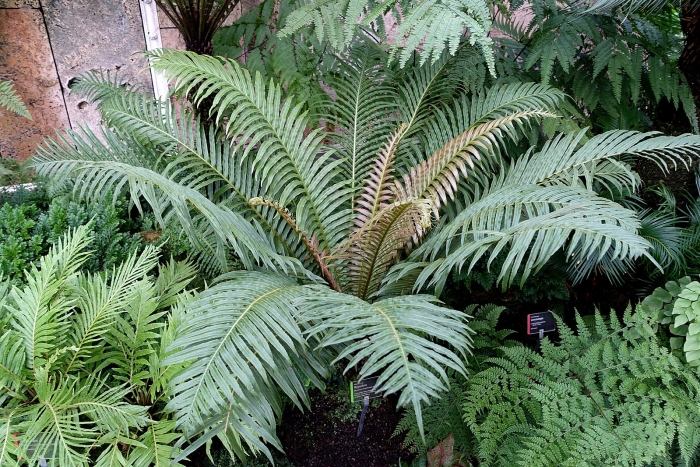Brazilian Dwarf Tree Fern
(Neoblechnum brasiliense)
Brazilian Dwarf Tree Fern (Neoblechnum brasiliense)
/
/

Daderot
CC0
Image By:
Daderot
Recorded By:
Copyright:
CC0
Copyright Notice:
Photo by: Daderot | License Type: CC0 | License URL: https://creativecommons.org/licenses/by-sa/3.0 | Uploader: Daderot | Publisher: Wikimedia Commons |
















Estimated Native Range
Summary
Neoblechnum brasiliense, commonly known as Brazilian Dwarf Tree Fern, is an evergreen fern native to the understory of humid forests and along stream banks in South America, particularly in Brazil. It is a relatively small fern, reaching up to 30 centimeters (12 inches) in height, with a compact growth habit. The new foliage emerges in a striking deep red to pinkish-red color before maturing to a glossy green, adding visual interest throughout the growing season. This fern is cultivated for its ornamental value and is particularly noted for its attractive foliage and manageable size.
Brazilian Dwarf Tree Fern is valued for its lush, tropical appearance and is often used in shaded garden areas, conservatories, and as a houseplant. It has received the Royal Horticultural Society’s Award of Garden Merit, indicating its excellence for garden use in the UK. Due to its sensitivity to cold, it requires protection from temperatures below 15°C (59°F), making it necessary to grow under glass in temperate regions. It thrives in part shade, preferring consistently moist conditions and well-draining soil with high organic matter. While it is not known for significant pest or disease issues, overwatering or poor drainage can lead to root rot. It is not considered invasive and does not pose problems with aggressive roots or invasiveness when grown outside its native range.CC BY-SA 4.0
Brazilian Dwarf Tree Fern is valued for its lush, tropical appearance and is often used in shaded garden areas, conservatories, and as a houseplant. It has received the Royal Horticultural Society’s Award of Garden Merit, indicating its excellence for garden use in the UK. Due to its sensitivity to cold, it requires protection from temperatures below 15°C (59°F), making it necessary to grow under glass in temperate regions. It thrives in part shade, preferring consistently moist conditions and well-draining soil with high organic matter. While it is not known for significant pest or disease issues, overwatering or poor drainage can lead to root rot. It is not considered invasive and does not pose problems with aggressive roots or invasiveness when grown outside its native range.CC BY-SA 4.0
Plant Description
- Plant Type: Fern
- Height: 2.5-5 feet
- Width: 3-5 feet
- Growth Rate: Moderate
- Flower Color: N/A
- Flowering Season: Non-Flowering
- Leaf Retention: Evergreen
Growth Requirements
- Sun: Part Shade
- Water: Medium, High
- Drainage: Slow, Medium
Common Uses
Deer Resistant, Low Maintenance, Potted Plant
Natural Habitat
Humid forests and stream banks in South America, particularly in Brazil
Other Names
Common Names: Brazilian Tree Fern, Red Brazilian Tree Fern, Red Dwarf Tree Fern
Scientific Names: , Blechnum brasiliense, Neoblechnum brasiliense, Blechnum nigrosquamatum, Blechnum corcovadense, Blechnum brasiliense var. angustifolium, Blechnopsis brasiliensis, Blechnum brasiliense f. multifida, Blechnum brasiliense var. corcovadense, Blechnum fluminense
GBIF Accepted Name: Neoblechnum brasiliense (Desv.) Gasper & V.A.O.Dittrich